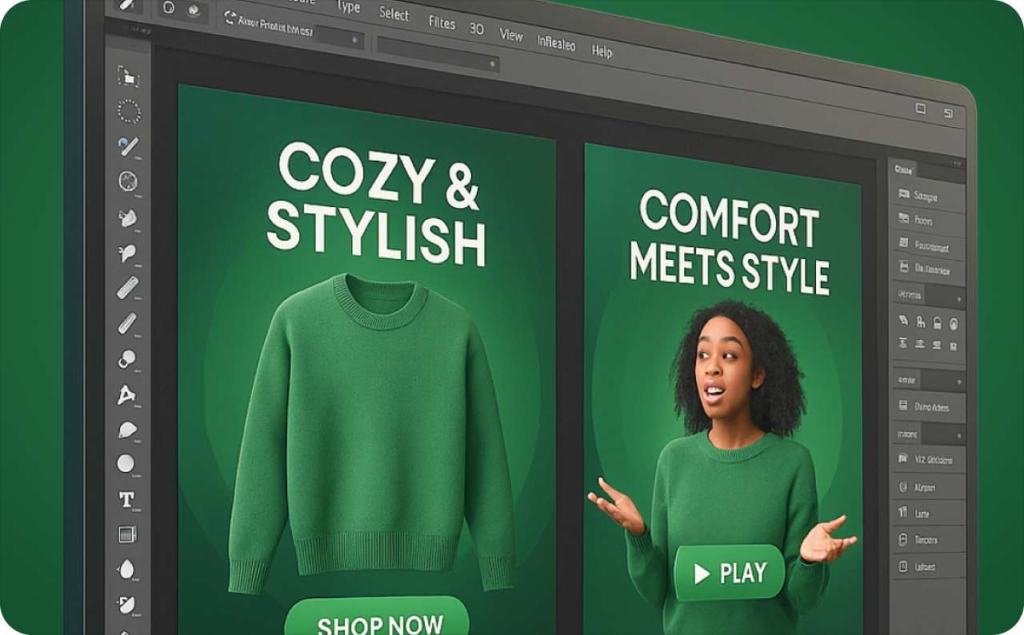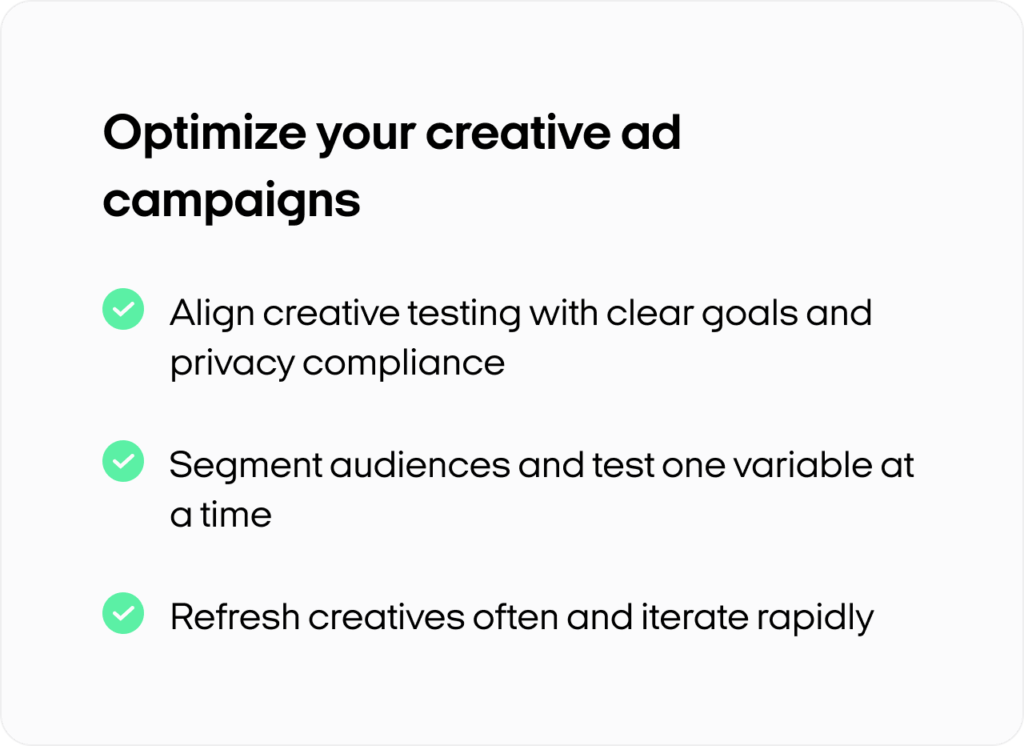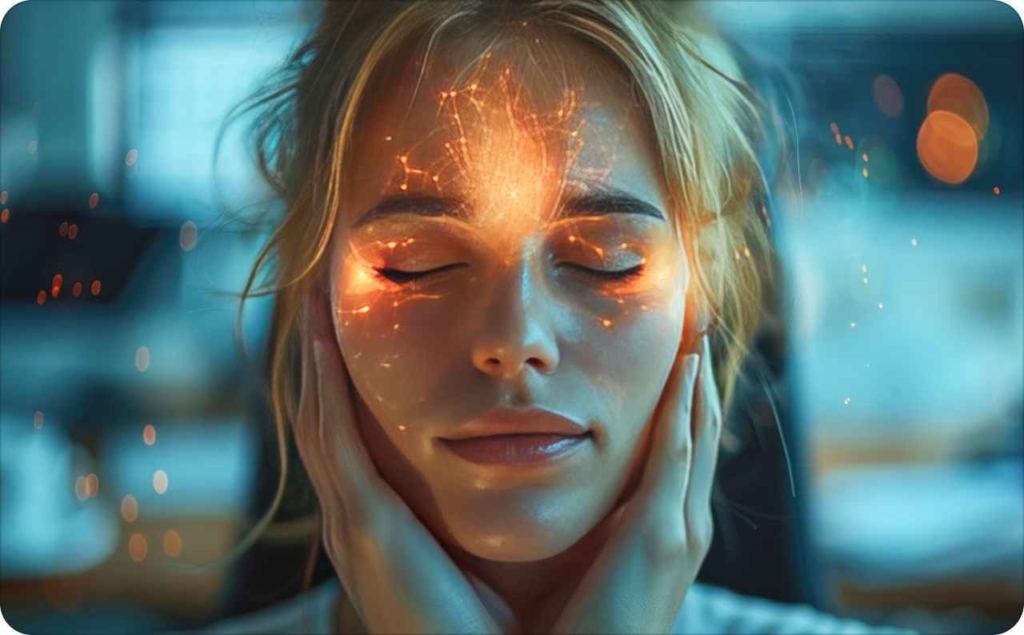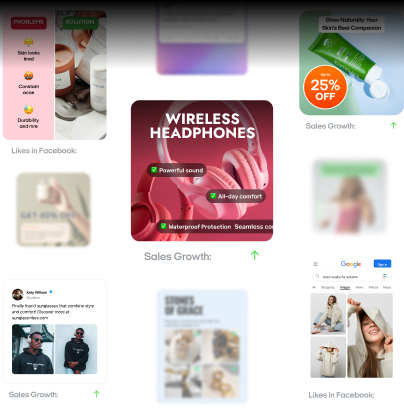Creative ad formats: Deep explanation & 5 tips for your ad campaign
Are you using the right ad formats for your goals? Here’s a deep breakdown and five expert tips to help your campaigns perform smarter, not harder.
If you feel like your digital ads are getting lost in a sea of competing content, creative ad formats change that. They turn ordinary banners into innovative ad executions. These ads drive clicks and increase user engagement.
Want to know a secret? Interactive elements, data-driven personalization, and a mobile-first approach that adapts to modern browsing habits.
What about a real example? LIVELY, a lingerie brand, used Facebook’s dynamic ads, which automatically selected the best mix of copy and imagery, and relied on auto placements to locate the most likely converters. As a result, LIVELY saw a 42% jump in purchases and a 62% increase in website traffic, all while maintaining a seamless experience for returning customers.
Creative ad formats are not just pretty pictures or splashy videos. They use tools like Dynamic Creative Optimization and rich media to tailor content in real time.
They can feature 360-degree experiences, swipeable slideshows, or clickable hotspots — anything that sparks brand recall and makes viewers linger. This approach aligns with NLP best practices, ensuring the right message hits the right audience at the right time.

Why creative ad formats matter
If your ad campaign is lost in endless scrolling, creative ad formats cut through the noise with fresh, interactive experiences that users can’t resist.
Does your audience ignore ads?
If ads aren’t getting overlooked, it may not be the format, but the audience. Creative ad formats break monotony, spark engagement, and respect privacy. They rely on interactive videos, swipeable galleries, and dynamic displays that catch the eye.
People crave more
Users want more than static banners. Creative ads deliver bold visuals and personal touches. Did you know that dynamic ads have higher click-through rates? That means deeper user engagement and stronger brand recall. According to Business Insider:
“Video ads have an average click-through rate of 1.84%, the highest click-through rate of all digital ad formats.”
Repetition kills
Showing the same ad repeatedly kills interest fast. Dynamic solutions swap out visuals, story angles, or add interactive quizzes. This keeps your brand fresh and battles ad fatigue.
Data privacy shifts
Privacy rules are tightening. Tracking alone no longer cuts it. Creative formats focus on relevance, not intrusiveness. For instance, an interactive quiz can offer product suggestions without using personal data. That approach builds trust and meets compliance needs.
Tying it all together
Creative ad formats offer user engagement and adapt to privacy changes. They blend with modern digital marketing, keeping your ads visible and your audience intrigued. Give them something new to explore, not just another ad to ignore.
Creative ad formats: A short overview
If you struggle to pick the right ad formats for your next campaign, you’re not alone. Many marketers face too many options without knowing which suits their campaign goals.
Below, you’ll find each innovative ad type explained in short bursts. We’ll also show how these interactive advertising formats solve common pain points.
Quick ad formats comparison
Check this table for a rapid overview of different creative advertising formats:
| Ad format | Best for | Key benefit | Complexity |
| Video ads | High engagement, brand awareness | Strong storytelling with video content | Medium |
| Dynamic ads | Personalized advertising, retargeting | Automated customization via Dynamic Creative Optimization | High |
| Showcase ads | Multi-product displays in one creative | Great for e-commerce and product recommendations | Low/Medium |
| Adaptive ads | Cross-device consistency | Automatic resizing for responsive ad formats | Medium |
| Rich media ads | Interactive and immersive experiences | Engaging features like 360° or lead forms | High |
| Image ads | Budget-friendly, quick branding | Simple visual storytelling with static or animated images | Low |
Video ads
Video ads use moving images and sound to capture attention fast. People remember them more than static images, making them great for engaging video ads. Keep it short — under 30 seconds, so viewers don’t drop off.
Focus on storytelling and end with a clear CTA. A playful 15-second spot can do wonders for user engagement and brand recall. According to The Entrepreneur, 92% of consumers prefer brands that make their ads feel like stories.
Dynamic ads
Dynamic ads personalize content in real time. They rely on user behavior to show the right products. With dynamic creative optimization, you can rotate images, headlines, and offers based on each viewer’s interests. It’s a powerful strategy for boosting conversion rate improvement when you want every impression to feel unique.
Showcase ads
Showcase ads feature multiple products in one layout. They’re perfect for showing off best sellers, fresh arrivals, or special bundles. This multi-product advertising tactic helps users explore a mini catalog without leaving the ad. Keep visuals top-notch, add brief text, and let product recommendations guide shoppers who aren’t sure what they want.
Adaptive ads
Adaptive ads adjust size and format automatically. This keeps your brand message consistent across desktops, tablets, and mobile. By offering a device-optimized look, you’ll increase click-through rates and avoid awkward cropping. If you need cross-platform exposure with minimal design fuss, this is your go-to responsive ad format.
Rich media ads
Rich media ads bring interactive features to standard placements. Think 360° views, swiping actions, or lead forms that pop up inside the ad. These immersive rich media ad examples invite deeper interaction. If you want to boost user engagement through dynamic storytelling, consider adding a short poll or demo within the ad itself.
Image ads
Image ads keep it simple. They rely on static or slightly animated visuals to convey brand identity. Animated advertising elements can catch the eye, but even a single striking image works. Great for quick campaigns or to test new creative ideas. Pair bold colors with crisp headlines for maximum impact on any ad platform.
Choose the right creative ad format
Look at your target audience and campaign goals first. Are you aiming for high engagement? Video or rich media ads can help. Need personalized advertising? Dynamic ads let you show custom offers to each viewer. Want to feature multiple items? Showcase ads do the trick. When you’re pressed for time or budget, image ads might be enough.
And if you’re juggling multiple devices, adaptive ads save you from design headaches. Each ad format has its strengths. Your strategy should revolve around what your audience values most — whether it’s visual storytelling, product personalization, or a smooth experience across every device.
Additional creative ad styles for D2C and social
Which creative ad styles work best for D2C brands on social media? Focus on problem solver ads, feature call-outs, UGC testimonials, influencer content ads, and founder stories. Each format highlights real solutions, sparks curiosity, and builds trust faster than generic campaigns.
D2C companies thrive on story-driven advertising that feels personal. Consumers want to see how a product tackles everyday hassles or offers unique perks. That’s where problem solver ads and feature call-outs shine. They address real-life challenges and then deliver a tangible fix..
Styles matched to social media advertising
Choosing the right social media advertising styles makes all the difference. Problem solver ads grab attention on TikTok or IG Reels with quick demos that lead with a relatable struggle.
Feature call-out ads flourish on Instagram Stories, where short frames emphasize key benefits. According to EMARKETER, about 98% of US creators share brand content via Instagram feed posts, Instagram Stories, and Instagram Reels.
UGC testimonials boost credibility in Facebook Carousels or IG Feeds by showing real customers and authentic reactions. Influencer content ads excel on YouTube or TikTok, tapping into influencer marketing strategies that build instant rapport. Founder stories naturally fit Instagram Reels or LinkedIn for an emotional, human touch.
Micro how-tos for social media creative tactics
While each style differs, the formula is simple:
- open with a pain point
- offer a quick fix
- close with a direct CTA
Problem solver ads highlight a common frustration, then show how your product solves it. Feature call-outs zoom in on a single perk, like vegan-friendly or 24-hour shipping. UGC in ads relies on photos or short videos from real customers, boosting authenticity.
Influencer-driven ads let a creator spotlight your brand in their own voice. Founder storytelling in advertising focuses on personal journeys that draw viewers in and spark emotional bonds.
Tracking D2C advertising strategies
Check analytics weekly. Watch metrics like engagement, conversions, and cost per action. If results lag, refine your message or try another platform.
By blending these D2C creative ad styles — from UGC testimonials to founder stories, and using social media creative tactics that fit each channel, you’ll build trust, enhance visibility, and keep customers excited about what you have to offer.
Testing & optimizing your creative ad campaigns
Most ads don’t fail because of bad products — they fail because they’re never tested. And in a world of privacy changes and limited data, that’s a big problem. Whether you’re running brand awareness on TikTok or trying to lower CPC on Meta, optimizing your creative is essential.
Let’s walk through a practical approach to test creative ads, reduce ad fatigue, and apply data-driven ad improvements that actually boost results.
Start with goals & privacy
First, define what success looks like. Are you optimizing for click-through rate, cost per lead, or conversions? Choose 1-2 core performance metrics for ads and align your creative ad testing strategy to them.
Next, consider privacy. With cookie deprecation and iOS tracking limitations, third-party data is fading. That doesn’t mean ad performance optimization is impossible.
You just need to lean on first-party data, like email engagement or site activity, and use aggregated reporting tools like GA4 or Meta’s Ads Manager. These privacy-compliant methods still give you enough insight to run effective A/B testing for ads.
Testing is important, according to ForceFive Media, it helps improve your campaigns over time by showing what resonates best with your audience.
Segment your audience and keep it simple
Not every user reacts the same way, so don’t treat them the same. Break your audience into segments by behavior or lifecycle stage. This audience segmentation allows you to personalize messages and creative types.
Start with high-traffic campaigns to get faster results. Imagine, you’re the owner of one D2C brand and ran two offers — “15% off” versus “Free shipping” — to first-time buyers. Free shipping won, lifting CTR by 20%. This test shaped your top-of-funnel optimization strategies going forward.
A/B test with a purpose
Effective A/B testing frameworks require structure. Change only one variable at a time — your headline, image, CTA, or ad format. Then run both versions simultaneously for 7–10 days or until each hits 1,000+ impressions.
Too many changes at once lead to murky results. Clean testing helps you see what actually drives performance metrics like conversions or cost per acquisition.
Rotate creatives before fatigue kicks in
If you notice drops in clicks, comments, or engagement, your ad is likely worn out. Rotating creatives regularly helps reduce ad fatigue and keep your audience engaged. Aim to refresh visuals or messaging every 2–4 weeks. Switch formats — move from static to video or carousel, and test new copy angles.
Monitor, learn, and iterate
Launch and leave is not a strategy. Weekly ad performance tracking is a must. Use GA4, Facebook Ads Manager, or TikTok Analytics to review campaign health. Look at engagement metrics, bounce rates, scroll depth, and conversions.
If something underperforms, refine your visuals, test a new CTA, or rework your copy. These iterative testing methods help you adjust quickly and stay competitive.

Best practices and case studies
Most creative ad best practices sound simple, but turning them into successful ad case studies can feel daunting. Let’s break down effective creative strategies, like brand alignment in ads, high-quality ad visuals, and data personalization, and see how real brands used these proven strategies to spark meaningful results.
Align your brand messaging
Brand-aligned creative ads make it easy for viewers to recognize you right away. If your color palette and tone don’t match your core identity, you risk losing trust.
Henry vacuum’s storytelling approach is a prime example: they introduced a friendly mascot and used consistent language in every ad. That cohesive style showcased brand alignment in ads, raising user engagement and reinforcing Henry’s cheerful persona.
Use high-quality ad visuals
Visuals can make or break personalized ad campaigns. People scroll fast, so you need high-impact ad visuals that grab attention. Bonza vegan dog food swapped dull stock photos for real-life pet images, combined with eco-friendly backdrops.
Those real-world examples of lively scenes resonated with their niche audience, jumping click-through rates by 30%. High-res photography or short, polished videos can also boost conversions, thanks to stronger emotional pull.
Personalize with data
Effective advertising strategies often hinge on relevance. If people see offers tailored to their interests, they’re more likely to click. Criteo’s dynamic ad performance proves this.
By matching product suggestions to each user’s browsing habits, they saw a notable lift in conversions, highlighting how personalized ad campaigns drive action when they align with real user data. Platforms like Facebook Dynamic Ads and Criteo’s DCO offer successful campaign tactics for targeting even as privacy rules evolve.
Test and refine for ongoing wins
No matter how strong your initial setup, iterative testing keeps ads fresh. Try new headlines, calls-to-action, or visuals, then measure what sticks. For example, according to Forbes:
“To be competitive, an organization has to frequently examine the ever-changing landscape, industry trends and the company’s targeted demographics. Häagen-Dazs was a high-quality but old-fashioned brand. In 2016, it successfully rebranded itself — new flavors, vibrant packaging and a revised logo, to target Millennials.”
By analyzing performance, you’ll refine effective creative strategies and avoid user fatigue.
Key takeaways
Ensure your ads reflect your core identity with matching logos, colors, and tone, while using sharp visuals to capture attention. Leverage real-time data for personalization and continually test small tweaks to uncover winning tactics.
By applying these creative ad best practices, you’ll turn real-life ad examples into your own successful ad case studies. Stick with brand messaging, invest in high-quality ad visuals, rely on data personalization, and test often. That formula shapes effective creative strategies that keep ads engaging, relevant, and ultimately profitable.
Conclusion
Throughout this guide, we’ve explored how brand alignment, high-quality visuals, data personalization, and iterative testing can bring your creative ad formats to life.
Some experts say that well-optimized campaigns can boost engagement by 70% and conversions by 150%. That’s a major win for any marketer facing privacy constraints or rising ad fatigue.
Recap of key creative ad formats
Video ads provide immersive storytelling with sight and sound. Dynamic ads personalize headlines and images in real time. Showcase ads display multiple products in a single view, while adaptive ads reformat themselves for different screens.
Rich media ads add interactivity, like 360° views or embedded polls. Image ads keep it simple with bold visuals for fast branding. And on social, founder stories and influencer content drive authenticity and deeper engagement.
Next steps to improve digital campaigns
First, audit your current approach — look at which formats you’re using and where your performance stalls. Then track key performance metrics — CTR, cost per action, and conversions, using tools like Google Ads, Meta Ads Manager, or GA4.
Watch for signs of fatigue, rotate your creatives, and rely on first-party data or aggregated insights to stay privacy-friendly. Each small tweak, from a new headline to a fresh layout, can add up in a busy digital space.
Have you noticed that creating advertising banners and videos takes too much time? Try Zeely AI and let artificial intelligence make creatives. In just 7–12 minutes, you will get a viral video, and in the meantime, you can create static advertising materials.
All you need is to install the application, provide information about your product or service, and pay for the plan. Try creating static and video ads, launch advertising, test different ad materials, choose the best ones, and boost conversions with Zeely AI!
Also recommended



